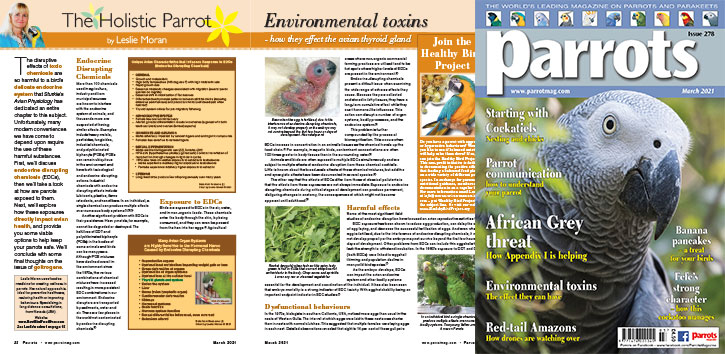
The Holistic Parrot by Leslie Moran
The disruptive effects of toxic chemicals are so harmful to a bird’s delicate endocrine system that Sturkie’s Avian Physiology has dedicated an entire chapter to this subject. Unfortunately, many modern conveniences we have come to depend upon require the use of these harmful substances. First, we’ll discuss endocrine disrupting chemicals (EDCs), then we’ll take a look at how are parrots exposed to them. Next, we’ll explore how these exposures directly impact avian health, and provide you some viable options to help keep your parrots safe. We’ll conclude with some final thoughts on the issue of goitrogens.
More than 100 chemicals used in agriculture, industry and from municipal sources are known to interfere with the endocrine system of animals, and thousands more are suspected of having similar effects. Examples include heavy metals, pesticides, fungicides, industrial chemicals, and polychlorinated biphenyls (PCBs). PCBs can remain ubiquitous in the environment and have both toxicological and endocrine disrupting actions. Industrial chemicals with endocrine disrupting effects include lubricants, plastics, flame retardants, and nanofibers. In an individual, a single chemical can produce multiple effects over numerous body systems.
Another significant problem with EDCs is their persistence. Heavy metals, for example, cannot be degraded or destroyed. The half-lives of DDT and polychlorinated biphenyls (PCBs) in the bodies of some animals and birds can be many years. Although PCB mixtures have declined overall in the environment since the 1970s, the various combinations of chemical mixtures have increased resulting in more persistent EDC combinations in our environment. Endocrine disruptors are transported by sediments, water and air. There are few places in the world not contaminated by endocrine disrupting chemicals.








Parrot Chat
Buyers Guides
Breeding articles